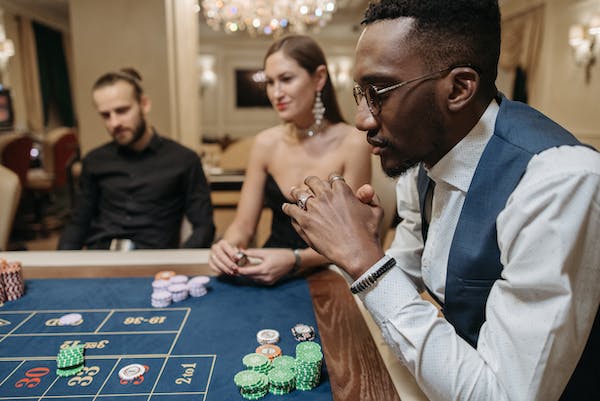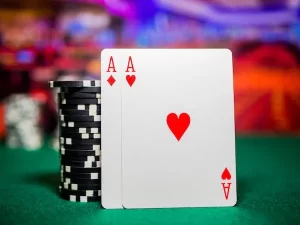The Psychology of Poker: How to Exploit Mindsets and Manipulate Actions is an article that delves into the psychological aspects of playing poker. It explores how players can use their knowledge of human behavior to gain an advantage at the table. The book covers topics such as reading opponents, understanding body language, and using psychological tactics to manipulate actions. It is a valuable resource for anyone looking to improve their poker game by understanding the psychology behind it.
The Importance of Understanding Player Psychology in Poker
One of the most critical aspects of player psychology in poker is the concept of tilt. Tilt refers to a player’s emotional state when they are frustrated, angry, or upset. When a player is on tilt, they are more likely to make irrational decisions and play poorly. As a result, understanding how to recognize and exploit tilt in your opponents can be a powerful tool in your arsenal.
Another essential aspect of player psychology in poker is the concept of hand reading. Hand reading is the process of analyzing your opponent’s actions and behavior to determine what cards they may be holding. By understanding your opponent’s hand range, you can make more informed decisions and increase your chances of winning the hand.
In addition to tilt and hand reading, understanding your opponent’s personality and playing style can also be beneficial. Some players are more aggressive, while others are more passive. Some players are tight and conservative, while others are loose and aggressive. By understanding your opponent’s playing style, you can adjust your strategy accordingly and exploit their weaknesses.
One of the most effective ways to exploit player psychology in poker is through the use of bluffing. Bluffing is the act of making a bet or raise with a weak hand in an attempt to deceive your opponents into thinking you have a stronger hand. Bluffing can be a powerful tool, but it requires a deep understanding of your opponent’s mindset and playing style.
Another way to exploit player psychology in poker is through the use of position. Position refers to your position at the table relative to the dealer. The later your position, the more information you have about your opponents’ actions, which can give you a significant advantage. By understanding your opponent’s mindset and playing style, you can use your position to manipulate their actions and gain an edge.
Finally, understanding player psychology in poker requires a deep understanding of your own mindset and emotions. Emotions such as fear, greed, and anger can cloud your judgment and lead to poor decision-making. By understanding your own emotions and mindset, you can make more informed decisions and avoid making costly mistakes.
In conclusion, understanding player psychology in poker is essential for any serious player. By understanding your opponent’s mindset and playing style, you can exploit their weaknesses and gain an edge at the table. Whether through the use of tilt, hand reading, bluffing, or position, understanding player psychology can give you a significant advantage in the game of poker. So, the next time you sit down at the table, remember to keep your eyes open and your mind sharp.
How to Use Body Language to Your Advantage in Poker
Body language is a powerful tool in poker. It can reveal a player’s confidence, nervousness, and even their hand strength. By observing your opponents’ body language, you can gain valuable information that can help you make better decisions at the table.
One of the most common body language tells in poker is the shaking of hands. This can indicate nervousness or excitement, which can be a sign of a weak hand. If you notice your opponent’s hands shaking, it may be a good time to make a bet or raise, as they may be more likely to fold.
Another tell to look out for is eye contact. If your opponent avoids eye contact, it may be a sign of weakness or deception. On the other hand, if they maintain eye contact, it could indicate confidence or a strong hand. By paying attention to your opponent’s eye contact, you can get a better sense of their mindset and adjust your strategy accordingly.
Posture is another important aspect of body language in poker. A player who is slouching or leaning back in their chair may be feeling relaxed or disinterested, which could be a sign of a weak hand. Conversely, a player who is sitting up straight and leaning forward may be more focused and engaged, which could indicate a strong hand. By observing your opponent’s posture, you can get a sense of their level of confidence and adjust your strategy accordingly.
Facial expressions are also a key component of body language in poker. A player who is smiling or laughing may be feeling confident or trying to bluff, while a player who is frowning or scowling may be feeling frustrated or angry. By paying attention to your opponent’s facial expressions, you can get a sense of their emotional state and adjust your strategy accordingly.
In addition to observing your opponents’ body language, it’s also important to be aware of your own. Your body language can reveal a lot about your mindset and hand strength, so it’s important to be mindful of how you present yourself at the table. Avoid fidgeting or tapping your fingers, as this can indicate nervousness or impatience. Instead, try to maintain a calm and confident demeanor, even if you’re feeling anxious or unsure.
In conclusion, body language is a powerful tool in poker. By observing your opponents’ body language and being aware of your own, you can gain valuable information that can help you make better decisions at the table. Remember to pay attention to your opponent’s shaking hands, eye contact, posture, and facial expressions, and adjust your strategy accordingly. With practice and patience, you can become a master of the psychology of poker and use body language to your advantage.
The Role of Emotions in Poker: How to Stay Calm and Focused
Emotions play a significant role in poker. Players who are unable to control their emotions are more likely to make mistakes and lose money. Emotions such as anger, frustration, and fear can cloud a player’s judgment and lead to poor decision-making. On the other hand, players who are able to stay calm and focused are more likely to make rational decisions and win more often.
One of the most important skills in poker is the ability to manage your emotions. This means staying calm and focused even when things are not going your way. It is important to remember that poker is a game of variance, and even the best players will experience losing streaks. The key is to remain patient and not let your emotions get the best of you.
One way to stay calm and focused is to practice mindfulness. Mindfulness is the practice of being present in the moment and fully engaged in what you are doing. In poker, this means focusing on the game and not getting distracted by outside factors such as other players or your surroundings. By practicing mindfulness, you can stay calm and focused even in high-pressure situations.
Another way to manage your emotions in poker is to take breaks when needed. If you are feeling frustrated or angry, it is important to step away from the table and take a break. This will give you time to calm down and refocus before returning to the game. It is also important to take breaks to avoid burnout. Playing poker for long periods of time can be mentally exhausting, so taking breaks can help you stay fresh and focused.
In addition to managing your own emotions, it is important to be aware of your opponents’ emotions. By understanding your opponents’ mindsets, you can exploit their weaknesses and manipulate their actions. For example, if you notice that a player is getting frustrated or angry, you can use this to your advantage by playing more aggressively and putting pressure on them.
Another way to exploit your opponents’ emotions is to use deception. By bluffing and making strategic bets, you can manipulate your opponents into making mistakes. For example, if you have a weak hand but want to make it seem like you have a strong hand, you can make a large bet to intimidate your opponents into folding.
In conclusion, the role of emotions in poker cannot be overstated. Players who are able to manage their emotions and stay calm and focused are more likely to make rational decisions and win more often. By practicing mindfulness, taking breaks when needed, and being aware of your opponents’ emotions, you can improve your poker game and increase your chances of success. Remember, poker is not just a game of cards, it is a game of psychology.
The Psychology of Bluffing in Poker: When and How to Do It
One of the most important aspects of poker psychology is bluffing. Bluffing is the art of making your opponents believe that you have a better hand than you actually do. It is a powerful tool that can help you win big pots and intimidate your opponents. However, bluffing is also a risky strategy that can backfire if not executed properly. In this article, we will explore the psychology of bluffing in poker and provide tips on when and how to do it.
Bluffing is a form of deception that relies on the psychology of your opponents. It works by exploiting their fear, doubt, and uncertainty. When you bluff, you are essentially trying to convince your opponents that you have a better hand than you actually do. This can be achieved through a variety of tactics, such as betting aggressively, acting confidently, and using body language to convey strength.
The key to successful bluffing is timing. You need to choose the right moment to bluff, when your opponents are most vulnerable and likely to fold. This requires careful observation of your opponents’ behavior and tendencies. For example, if you notice that a player is easily intimidated by aggressive betting, you may want to bluff when they are in the pot. Similarly, if you notice that a player is prone to calling with weak hands, you may want to bluff when they are in the pot.
Another important factor to consider when bluffing is your table image. Your table image is the perception that your opponents have of you based on your previous actions and behavior. If you have been playing tight and conservative, your opponents are more likely to believe that you have a strong hand when you bet aggressively. On the other hand, if you have been playing loose and aggressive, your opponents may be more likely to call your bluff.
When bluffing, it is important to be consistent with your behavior. If you suddenly start acting differently, your opponents may become suspicious and call your bluff. For example, if you have been playing conservatively all night and suddenly start betting aggressively, your opponents may assume that you are bluffing.
Body language is also an important aspect of bluffing. Your body language can convey a lot of information to your opponents, such as confidence, nervousness, and uncertainty. When bluffing, it is important to maintain a confident and relaxed demeanor. Avoid fidgeting, sweating, or looking around nervously. Instead, maintain eye contact with your opponents and act as if you have a strong hand.
In conclusion, bluffing is an essential part of poker psychology. It requires careful observation of your opponents’ behavior and tendencies, as well as a good understanding of your own table image and body language. When executed properly, bluffing can be a powerful tool that can help you win big pots and intimidate your opponents. However, it is also a risky strategy that can backfire if not executed properly. Therefore, it is important to use bluffing sparingly and only when the timing is right. With practice and experience, you can become a master of the art of bluffing and take your poker game to the next level.
The Power of Observation in Poker: How to Read Your Opponents
The first step in reading your opponents is to pay attention to their behavior. This includes their body language, facial expressions, and verbal cues. For example, if a player is fidgeting with their chips or constantly checking their phone, they may be nervous or distracted. On the other hand, if a player is sitting up straight and making direct eye contact, they may be confident or trying to intimidate their opponents.
Another important aspect of reading your opponents is to pay attention to their betting patterns. This includes the size of their bets, the timing of their bets, and their overall strategy. For example, if a player consistently bets big on strong hands and small on weak hands, they may be predictable and easy to exploit. Conversely, if a player varies their bets and bluffs frequently, they may be more difficult to read and require a different approach.
It is also important to consider your opponents’ personalities and playing styles. Some players are aggressive and like to take risks, while others are more conservative and prefer to play it safe. By understanding your opponents’ personalities and playing styles, you can adjust your own strategy accordingly. For example, if you are playing against an aggressive player, you may want to play more defensively and wait for them to make a mistake. Conversely, if you are playing against a conservative player, you may want to take more risks and try to force them out of their comfort zone.
One of the most effective ways to read your opponents is to use deception and manipulation. This involves intentionally giving off false signals or playing mind games to throw your opponents off their game. For example, you may pretend to be nervous or unsure when you have a strong hand, or you may bluff frequently to make your opponents doubt their own hands. However, it is important to use deception and manipulation sparingly and strategically, as overusing these tactics can backfire and make you appear untrustworthy or unpredictable.
In addition to reading your opponents, it is also important to be aware of your own behavior and how it may be perceived by others. This includes your body language, facial expressions, and verbal cues. For example, if you are constantly checking your phone or looking around the room, you may appear distracted or disinterested. On the other hand, if you are sitting up straight and making direct eye contact, you may appear confident and in control.
In conclusion, the power of observation is a crucial skill in poker. By paying attention to your opponents’ behavior, betting patterns, personalities, and playing styles, you can gain valuable insights into their mindset and use this information to your advantage. Whether you are using deception and manipulation or simply playing defensively, the ability to read your opponents is what separates the best players from the rest. So the next time you sit down at the poker table, remember to keep your eyes and ears open and use the power of observation to your advantage. The Psychology of Poker: How to Exploit Mindsets and Manipulate Actions is a comprehensive guide that explores the psychological aspects of poker. It provides insights into the different mindsets of players and how to exploit them to gain an advantage. The article also delves into the art of manipulation and how to use it to control the actions of opponents. Overall, the book is a valuable resource for anyone looking to improve their poker game by understanding the psychology behind it.




